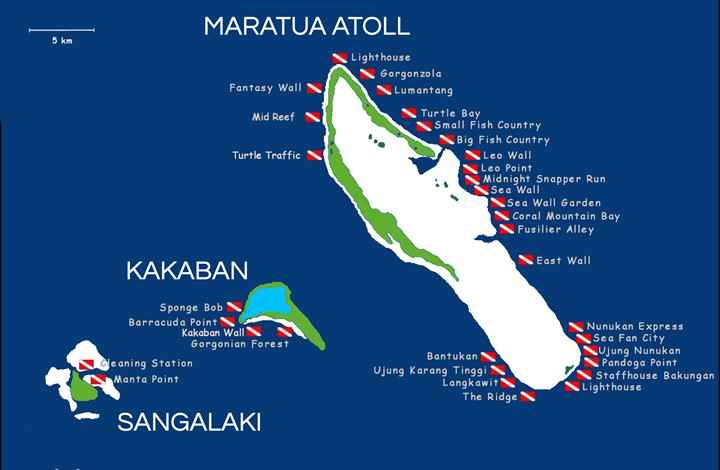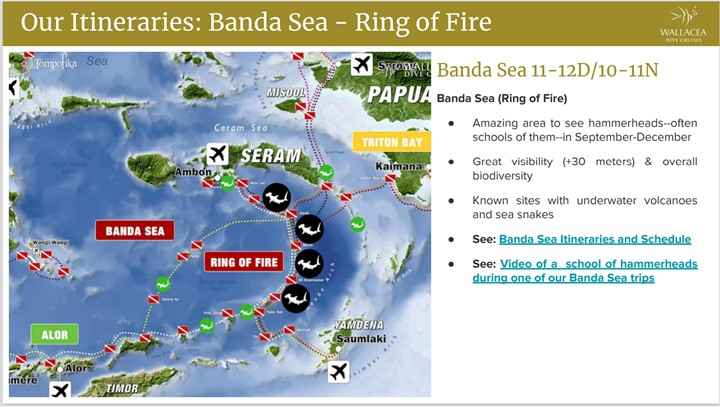The Seahorse was entirely refurbished in 2018 in Kendari (South Sulawesi) by the most respected marine carpenters of the country, making this fantastic vessel one of the best diving liveaboards in Indonesia. Seahorse luxury Liveaboard is a traditional Indonesian wooden sailing Phinisi offering scuba diving trips and adventure charters to the best sites of Indonesia. The arrangement of the cabins, lounges, diving deck, accessibility...every little detail has been re-thought to offer the amenities and comfort of a 5-star floating hotel. A crew of 16 comes with her make your cruise in Indonesia an unforgettable experience!
At 33 meters long (38 LOA) and 8.5 meters beam, the Seahorse is a practical and spacious vessel, built by divers and able to accommodate up to 16 guests in 6 Twin and 2 Double cabins attended by 12 crews and 4 Dive Masters. Our two very spacious 22 feet custom-built aluminum tender boats will make your experience of going in /out of the sea very easy and comfortable.
To see a virtual tour of the boat click HERE

The boat accommodates up to 16 guests in 6 Twin and 2 Double cabins. All of the spacious cabins have individually controlled air-conditioning and private en-suite bathrooms with hot water. The classic beauty of the Seahorse combines traditional craftsmanship with modern conveniences and safety features providing charming comfort in the remotest waters of Indonesia. Towels and toiletries, soap, shampoo, and toothpaste are provided on board.
Raja Ampat Ultimate (11 nights)
Day 1
Guest reception at Sorong airport, check in, welcome drink, briefing, departure in the evening. According to the weather forecast, we will start the tour by the south or the North. In this schedule, we present the option starting with the South. Overnight Navigation through Sele Strait to reach the East of Misool. Arrival in the early morning.
DAYS 2-4
In East Misool you will discover 3 fantastic dives: No contest, Love potion, 3 Rocks. Rocks with vertical walls and fantastic coverage of soft corals, lot of fishes with schools of Platax, aggregations of snappers, bump head parrotfishes. We spend the night in the hidden lagoon, a very special anchorage inside an almost closed bay surrounded by high rocks. From the boat, we can hear and see the cachants before the night falls. We will go with the dinghies to have a look at another lagoon. After a short morning navigation, we will go to Misool South East and start another day of diving in the vicinity of Misool eco-resort: Boo Rocks with 2 large openings in the rock that completely pierce the island from the surface to 5 meters deep, Fiabacet, Fantasea.A gain an explosion of colors and fish density. In the evening, we organize a dinner on the beach of a small island. Misool east. Fashion dives in Misool, Yellit Kecil , a great wall with excellent fans and soft corals, rock tank, Nudi rock . Night navigation to Penemu and Fam Islands. Overnight navigation to Penemu.
DAY 5
Spots : Black Rockfiber• Black forest
Penemu North, Barracuda , has a long, long life with great aggregations of fishes (barracudas, fusiliers and banner fish), Galaxy , a great reef with excellent fish life, an excellent site for it's hard corals. Navigation to Aljuy bay.
DAYS 6-7
Spots : Chango Dive Sitefiber • EAGLE ROCKAfter an early morning dive at Mayhem, a very high voltage submerged reef, we enter in Aljui Bay, has 20 long indentation kilometers on the western side of Waigeo. We do 2 dives in the bay ( wofoh and Intersection ), then one of the best night dives of the Raja Empat under the peer of a pearl farm that is settled there. We still do 2 dives in Aljuy bay, Aljui 1 and the Channel . These two dives we will have a short visit to the pearl farm if their work schedule allows it. Night navigation to Wayag islands.
DAY 8
Wayag, the northern point of our cruise is a fantastic quartz islets labyrinth. We dive Quoy, rock cathedrale and Wayag ridge. In the late afternoon, we climb to a small mountain to admire the wonderful landscape of the area.
DAY 9After a first dive in Wayag (figure eight), we go to the Kawe island where we dive Black rock and eagle rock . Night dive. Night navigation to Dampier strait.
DAYS 10-11
A first morning dive at Citrus - at the entrance of the Dampier strait, a channel with sloping sides covered with soft corals and life-then with a reliable manta ray congregation at manta sandy . Cape Kri , one of the largest concentrations of big fish on the northern Raja Ampat; schools of trevally, barracudas, bannerfish, sweetlips. Night diveTwo other famous and fabulous dives in the Dampier Strait, Chicken reef and sardine reef. The boat will sail to Sorong where it will arrive during the evening.
DAY 12
Breakfast, Check-out according to guests' flight schedule. Transfer to the airport, check-in assistance.
DIVING IN DERAWAN ISLANDS
One of Indonesia's underrated hidden gems for scuba divers, Derawan Islands in East Kalimantan (East Borneo) offers some of Indonesia's richest underwater life. In fact, Derawan ranks just second to Raja Ampat in terms of coral diversity with over 460 different species of corals. While Derawan is mostly known in the scuba diving sphere for its manta rays and whales sharks, there are actually over 870 fish species inhabiting this area. Whether you're into tiny critters or bigger fish, there will be no shortage of marine life to see!
This archipelago also hosts Indonesia's largest nesting site of the endangered hawksbill turtles and giant green turtles, where you can watch them lay their eggs in the sand! Furthermore, Derawan is also one of the 4 places in the world where you can swim with stingless jellyfish. You rarely find a dive destination as varied as Derawan. Other species that may be seen in the area include hammerhead sharks, thresher sharks, leopard sharks, dolphins, dugongs, and barracudas. While there is still large room for exploration, four islands stand out for diving and snorkeling.
DERAWAN DIVE SITES MAP
There is still room for further exploration, but the main dive sites in Derawan are currently spread across its 4 main islands: Kakaban, Sangalaki, Maratua, and Derawan. The dive sites greatly vary with plenty of caves, wrecks, muck, walls, and reefs to choose from.
Diving in Maratua
The world-renowned dive sites “The channel” AKA “Big Fish Country” are predominantly located on the east part of this 35.5 square kilometers U-shape island. On the drop-offs the current is strong: prepare your hook and get ready for the show! Outstanding schools of barracudas, reef and grey sharks, eagle rays, thresher sharks, giant grouper, school of Jackfish, schools of Bumphead parrotfish, turtles, and many more are frequent encounters, not to say, residents.
Pelagic of course but also colorful and super healthy corals. Another dive site for turtle fanatics: "Turtle Traffic". If you manage to count all the turtles you see there: then you’ve been unlucky as it was a bad day. 13 caves are connected to the sea White sand beach to chill and tan: a taste of paradise.
Diving in Kakaban
This is where you get to swim with various species of endemic jellyfish! This island which consists of a salty lake fridged by a mangrove was originally a lagoon surrounded by a coral atoll. Thousands of years ago a geological motion raised this atoll creating the island and its lake. The species stays isolated since then created a unique biota. The brackish water and bottom covered marine green algae host many species. 4 different species of endemic jellyfishes, tunicates, nudibranchs, crustaceans, sea cucumbers, anemones, and other critters. Just like is Palau in Micronesia. The harmless jellyfishes are non-stinging: no need to wear a wetsuit. Barracuda point is another highlight of this island. Pelagic such as sharks and tunas hunt around big time!
The outer ring of Kakaban island offers divers a wide variety of spots from corals, big pelagic, and also the thrilling cave dive (experienced divers only).
Diving in Sangalaki
Well known for its manta ray cleaning station all year round while there are several other spots to encounter mantas, Sangalaki Island is also home to a turtle nursery run by the local government. Thousands of eggs are laid there! When they hatch baby green sea turtles orient themselves with the moonlight reflected on the sea. So any other light misleads them in the right direction to take. The outstanding coral gardens and a drink during Sunset on the sandy beaches will make your trip-to-paradise and unforgettable experience.
Diving in Derawan
Scuba diving in Derawan is mostly drift and muck diving. Flamboyant cuttlefish, mandarin fish, ghost pipefish, frogfish, blue ring octopus, harlequin shrimp, and tiger shrimp to name a few. Especially a place for photographers, who always want to get a picture of jawfish with eggs.
Diving in Talisayan
Just like in Triton Bay and Cendrawasi, Derawan's Bagans (fishing platforms) are frequented by whale sharks who come early in the morning to suck the fishing nets full of anchovies. During the southwest monsoon (June to September), bagans usually move out to Talisayan. Whale sharks follow and so we will. Divers and snorkelers can approach them for as long as they like. With a depth never exciding 8 meters, it's frequent to see divers around for up to 2 hours!
Diving in Pulau Panjang
Muck diving. Recently seen Satomi Pigmy and sea dragon.
HOW TO GET TO DERAWAN
Tarakan in Indonesia is a gateway to Derawan. Most of our cruises (not all of them) depart from Tarakan: a small island on the Northern East part of Kalimantan (Borneo). Please refer to the pdf of the selected itinerary for more details.
Well served with 2 daily morning flights from the main International Indonesian Airports such as Jakarta, Makassar, Manado. Tarakan is Jakarta time + 1.


Length: 33 m (108 ft)
Beam: 8,5 m (28 ft)
Draft: 3.5 m (11,5 ft)
Displacement: 177 tons
Construction: Wooden ship, Type Phinisi
Engine: M.A.N. 2866 LXE Marine Turbo Diesel 400 HP
Speed: 8-9 knots
Range: 3,000 nautical miles
Tenders: Two 6.5 meter aluminium boats equipped with 100 HP Yamaha 4 strokes engines, VHF radios and depth sounders
Generators:
• 1 x Mitsubishi 40 KVA 220-380 v
• 1 x Mitsubishi 60 KVA 220-380 v
• 1 x Yanmar 22 KVA 220-380 v
Voltage: 220 V, 50 Herz
Fuel Tank: 20,000 litres
Water Tank: 11,000 liters of fresh water storage, 6,000 liters per day water maker
Safety: 3 x 12 man self-inflatable lift-rafts, smoke detectors in all cabins, 2 emergency oxygen units
Compressors:
• 2x Bauer Mariner HP breathing air compressors
• 1x CompAir Low-pressure Screw Compressors with membrane for NITROX
Scuba Tanks: 32 SCUBA tanks, 12 L. Two 15 L tanks available on request (supplement applied)
Electronics: EPIRB emergency locator, Sat-phone, FM & SW Radio, 4 VHF and SSB Radio, Furuno 90 NM radar, 2 x GPS w/Plotter and Depth Sounder Furuno
Miscellaneous:
• Library with fish ID books and paperbacks
• Camera Room
• Dedicated indoor camera room with direct access to/from cabins "Sea View".
• Large table on the diving deck
Accommodation
• 16 guests in 2 double bed and 6 twin bed cabins.
• All cabins have en-suite bathroom + hot water and individual AC control
Crew: 12 Crew + 4 Divemasters
Check out the boat HERE